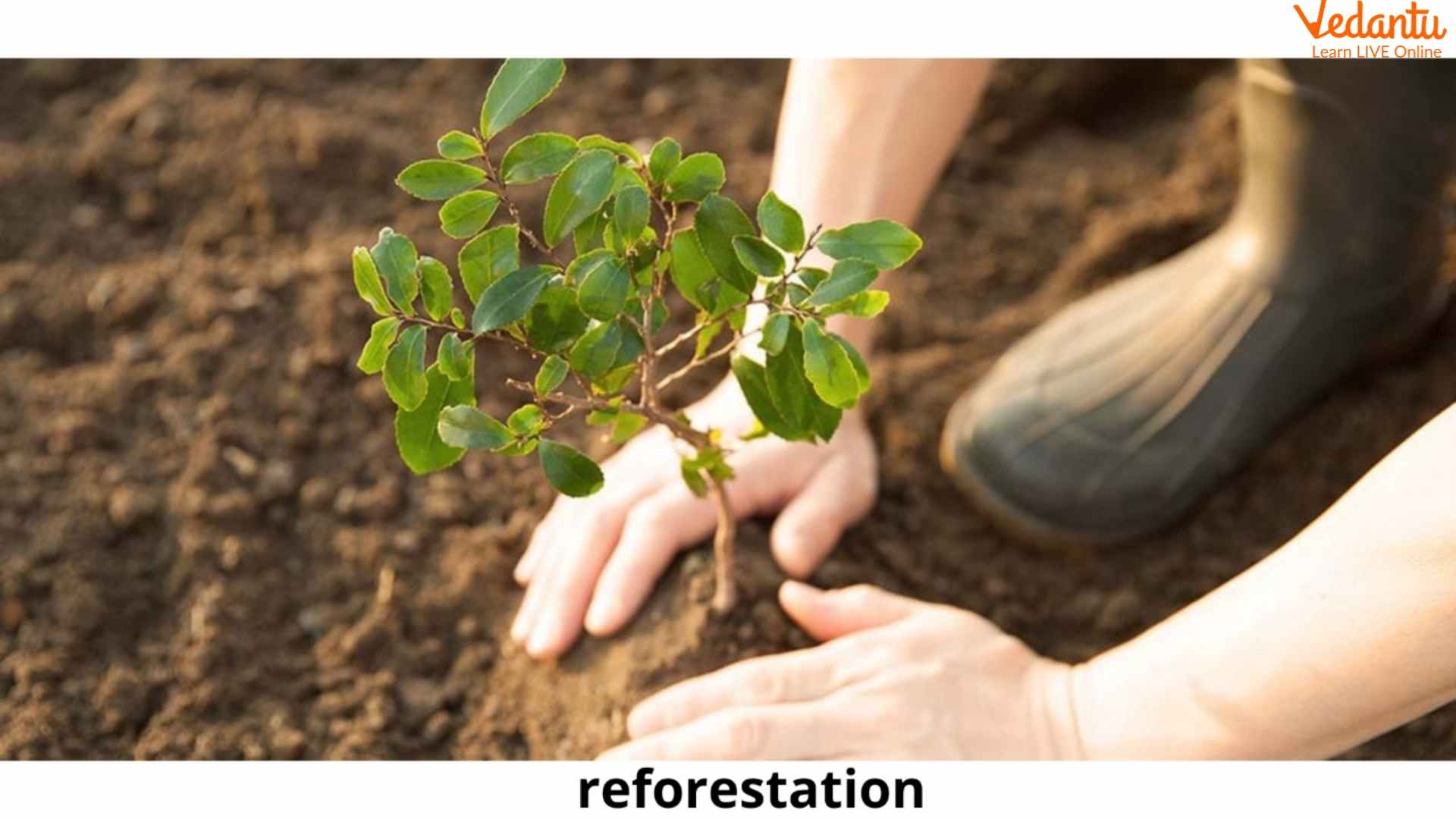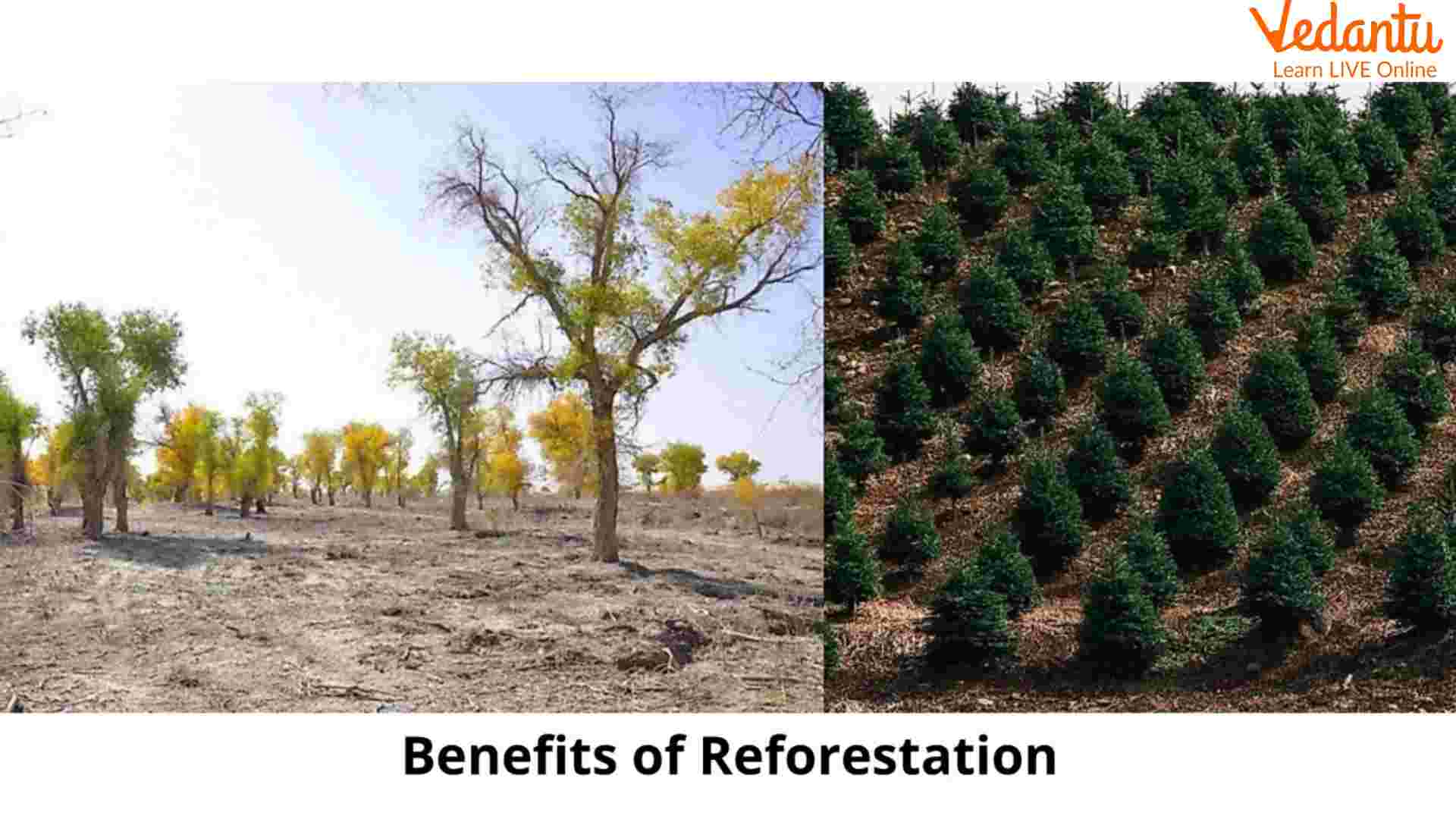




Reforestation: An Introduction
Reforestation is the practice of restoring or replacing forests that have been damaged or destroyed for the benefit of people. Both the terms "reforestation" and "afforestation" denote the same thing; afforestation is simply another word for reforestation. Forests occasionally have the potential to regenerate because of the nearby trees or because of the dispersal of seeds. However, severely damaged forest areas cannot regrow unless native plant species are introduced.

Plantation for Reforestation
What is Reforestation?
Reforestation is the process of replacing trees in places that have been damaged by both natural and human-made disturbances, such as logging, mining, agricultural clearance, and construction. Natural disturbances include wildfires, drought, pest and disease infestations, and wildfires. This might entail anything from encouraging natural regeneration in a degraded region to planting ecologically suitable tree seedlings in the wake of forest fires.
Reforestation can take place naturally or under human management. An area is simply left unaffected by human activities in natural reforestation. Plants that are planted in the ground or transported there by the wind and water movement sprout and develop. According to a succession of plant species that are typical of that region, the forest eventually returns.
Reforestation Definition
Reforestation is the process of re-establishing forests after they have been destroyed using local tree species. Afforestation, the process of re-establishing woods that formerly existed but have been cleared, is another name for reforestation. The recovering forest may help the ecosystem, protect endangered species, replenish key resources, and even help the attempt to prevent global warming by removing carbon dioxide from the atmosphere.
Why is Reforestation Important?
The function that trees play on our world explains the significance of reforestation. New woods are crucial to protect farms and houses from wind and to stop desertification of soil erosion. The coastal area is strengthened and stabilised by trees along riverbanks or shorelines. The native habitat of rare species, some of which are found nowhere else, is the woods. In order to restore the tree cover, it's crucial to both regenerate the damaged or destroyed areas and plant new ones.
How are we implementing Reforestation?
Numerous groups are striving to conserve and restore forests using a variety of techniques, such as educating people about the value of forests, replanting, and the expansion of protected areas. Additionally, governments throughout the world are working to enact tight regulations for the preservation and regrowth of forests. A sustainable and balanced ecology can only be achieved via worldwide cooperation.
Benefits of Reforestation
Fixes atmospheric carbon dioxide in their leaves, trunks, and roots, assisting in carbon sequestration.
Absorbs air pollutants into the leaves and bark to remove them.
Grows roots that hold the soil together to stop soil erosion.
More than 80% of the world's terrestrial biodiversity depends on it for habitat.
Reduces the temperature of the surrounding air by up to 8 degrees Celsius, acting as natural air conditioners.
Lessens the effects of climate change and global warming
Helps to safeguard threatened species.
Our drinking water through their roots to filter.
Prevents landslides and floods by soaking up water and gradually releasing it through transpiration.

Conclusion
The continuation of modern human culture is universally dependent on forests and the things they produce. We typically do not even think it is even worthy of further inquiry to modify our civilization such that it does not depend on the forest (to the forest's disadvantage) and its accompanying advantages. As a result, it is crucial that we develop methods for managing the forest sustainably so that it can give all of its potential advantages.
FAQs on What is Reforestation and Why is it Important?
1. How is the carbon dioxide cycle affected by reforestation?
According to Dr. James Hansen, a leading authority on climate science, we must limit CO2 emissions and take all necessary steps to remove CO2 from the atmosphere, where it remains for 80 to 100 years. As long as the trees are still standing and the soil is not disturbed, forests are the ideal place to store CO2. "Photosynthesis is a natural process through which trees and plants use energy from the sun and carbon dioxide from the air to generate the food they need to survive and develop."
2. Why don't we have enough trees on the planet to compensate for the carbon emissions of society?
All land on the earth could support as much flora as possible, which would absorb enough carbon to balance nearly ten years' worth of greenhouse gas emissions at the current rate. After that, carbon capture could not be increased any further.
However, before expanding the forest environment, we must make sure that trees are planted in the proper locations because not all terrestrial ecosystems can or should sustain trees. In habitats where other forms of plants predominate, planting trees frequently has little to no long-term effect on carbon sequestration.
3. What impact does deforestation have on wild animals?
Eighty percent of all terrestrial animals and plants on Earth are found in forests, and extinction-threatened amphibian species including the orangutan, sumatran tiger, giant Brazilian otter, lazy bear, pink amazon dolphin, rhino, elephant, golden toad, and frogs are all at risk due to deforestation. Several different bird species, including toucans and hyacinth macaws. Removing trees and other vegetation limits the amount of food, habitat for breeding, and shelter that is available.
50,000 species of animals go extinct per year as a result of deforestation, or 137 species every day.










